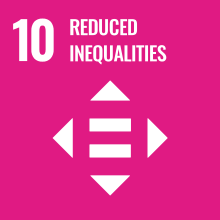| Sustainable Development Goal 10 | |
|---|---|
 | |
| Mission statement | "Reduce inequality within and among countries" |
| Commercial? | No |
| Type of project | Non-Profit |
| Location | Global |
| Founder | United Nations |
| Established | 2015 |
| Website | sdgs |
Sustainable Development Goal 10 (Goal 10 or SDG 10) is about reduced inequality and is one of the 17 Sustainable Development Goals established by the United Nations in 2015. The full title is: "Reduce inequality within and among countries".[1][2]
The Goal has ten targets to be achieved by 2019. Progress towards targets will be measured by indicators. The first seven targets are outcome targets: Reduce income inequalities; promote universal social, economic and political inclusion; ensure equal opportunities and end discrimination; adopt fiscal and social policies that promotes equality; improved regulation of global financial markets and institutions; enhanced representation for developing countries in financial institutions; responsible and well-managed migration policies. The other three targets are means of implementation targets[3]: Special and differential treatment for developing countries; encourage development assistance and investment in least developed countries; reduce transaction costs for migrant remittances.[2]
Target 10.1 is to "sustain income growth of the bottom 40 per cent of the population at a rate higher than the national average". This goal, known as "shared prosperity", is complementing SDG 1, the eradication of extreme poverty, and it is relevant for all countries in the world.[4] There has been a growth in income for poorer people in 2012–2017. Nevertheless, it is common in many countries that "the bottom 40 per cent of the population receive less than 25 per cent of the overall income".[5]: 12
A UN report from 2020 pointed out that "women are more likely to be victims of discrimination than men".[6]: 44 And the situation is even worse for women with disabilities.[6]: 44
- ^ United Nations (2015) Resolution adopted by the General Assembly on 25 September 2015, Transforming our world: the 2030 Agenda for Sustainable Development (A/RES/70/1)
- ^ a b United Nations (2017) Resolution adopted by the General Assembly on 6 July 2017, Work of the Statistical Commission pertaining to the 2030 Agenda for Sustainable Development (A/RES/71/313)
- ^ Bartram, Jamie; Brocklehurst, Clarissa; Bradley, David; Muller, Mike; Evans, Barbara (December 2018). "Policy review of the means of implementation targets and indicators for the sustainable development goal for water and sanitation". npj Clean Water. 1 (1): 3. doi:10.1038/s41545-018-0003-0. S2CID 169226066.
 Text was copied from this source, which is available under a Creative Commons Attribution 4.0 International License
Text was copied from this source, which is available under a Creative Commons Attribution 4.0 International License
- ^ "What We Do". World Bank. Retrieved 2019-03-10.
- ^ Cite error: The named reference
UNESC2020was invoked but never defined (see the help page). - ^ a b United Nations (2020) Sustainable development goals report Archived 30 December 2020 at the Wayback Machine, New York